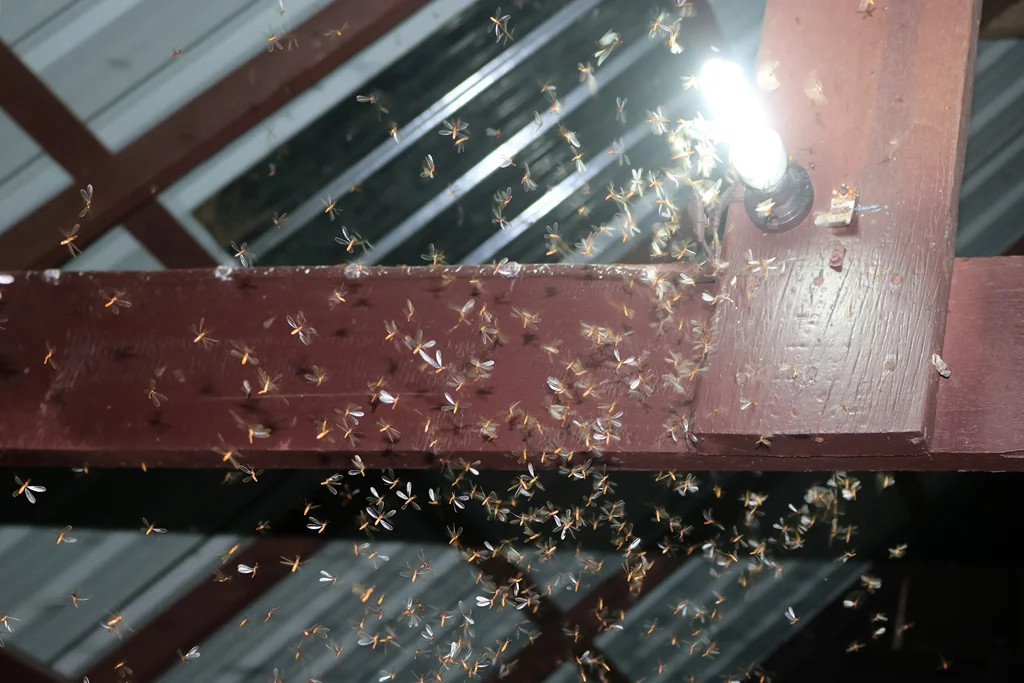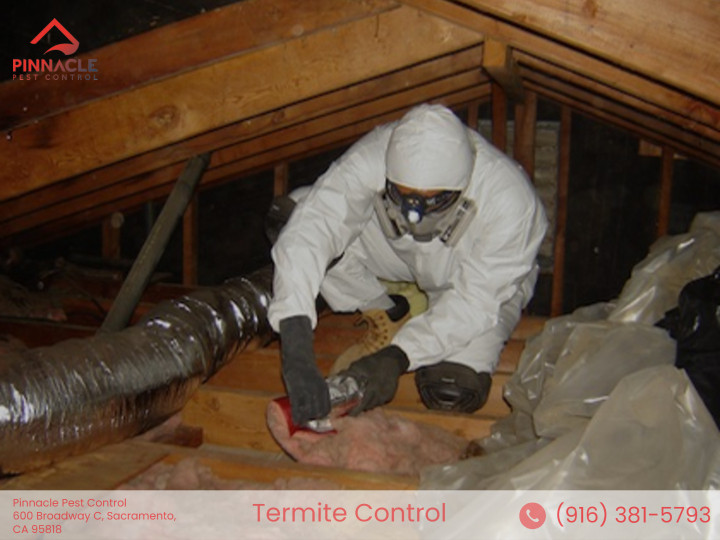Discovering flying insects near or inside your home can be alarming, and if those insects resemble termites, it’s a serious cause for concern. The presence of flying termites often signals one of two unwelcome scenarios: an existing termite infestation in your property or the imminent threat of one. Termites, particularly subterranean termites, are notorious for causing significant structural damage as they establish colonies and their offspring begin to feed on wood structures.
While both flying termites and subterranean termites are types you might encounter, it’s crucial to understand the relationship between them. Both can silently and steadily damage your home, leading to costly repairs. However, it’s important to clarify that “flying termites” are not a separate species but rather a phase in the life cycle of certain termites, including subterranean termites, and their appearance is often a key indicator of a larger termite problem. Recognizing the signs of both flying and subterranean termites is vital for proactive home protection and can save you considerable trouble and expense in the long run.
Call Today for a Termite Inspection
Don’t let termites take over your home. Pinnacle Pest Control offers expert termite inspections and treatments to ensure your home remains pest-free. Schedule your inspection now to safeguard your property.
Flying Termites vs. Subterranean Termites: Key Differences
It’s a common misconception that termites are flying insects in the same way as wasps or mosquitoes. In reality, only a small percentage of termites are capable of flight, and even then, it’s only for a brief period. Termite colonies are structured into castes, each with specific roles. Understanding these castes helps clarify the role of “flying termites”:
- King and Queen: The reproductive center of the colony.
- Workers: Responsible for foraging food, building tunnels, and caring for the young.
- Soldiers: Defend the colony from predators.
- Alates (Flying Termites or Swarmers): These are the only termites capable of flight and are sexually mature. They are destined to become the kings and queens of new termite colonies. Swarming is their characteristic flight behavior for reproduction.
So, Do Subterranean Termites Fly? The answer is nuanced. Subterranean termite workers and soldiers, the main body of the colony that causes damage, do not fly. However, subterranean termite colonies, like those of other termite species, produce alates or swarmers. These are the reproductive members of subterranean termite colonies, and they do fly during swarming season to mate and establish new colonies. Therefore, seeing “flying subterranean termites” actually means you are seeing the swarmer caste of a subterranean termite species.
The Phenomenon of Flying Termites (Swarmers)
Termite swarming, or flying behavior, is primarily for reproduction and colony expansion. The termite lifecycle includes a stage where sexually mature termites, the alates, emerge from their nests and take flight. This is similar to the nuptial flight seen in ants and other insects. These flying termites gather in swarms, often in the air, to mate with termites from different colonies of the same species. After successful mating, these termites land, shed their wings, and begin the process of establishing a new colony.
Understanding Subterranean Termites
Subterranean termites are often considered the most destructive type of termite, responsible for a significant amount of termite damage. They are named “subterranean” because they typically live in the soil and build intricate tunnel systems known as “mud tubes.” These tubes serve as pathways to food sources and protect them from open air and predators.
Subterranean termites are relentless eaters, consuming wood 24/7. Their saw-toothed jaws allow them to chew off tiny pieces of wood, gradually weakening wooden structures. Over time, subterranean termite activity can severely compromise a building’s structural integrity, potentially leading to collapse if left untreated.
Identifying Flying and Subterranean Termites
Distinguishing flying termites from other flying insects is possible with close observation. The appearance of flying termites can vary slightly depending on the species, but they share common characteristics. Typically, flying termites are similar in color to other castes within their colony, often appearing beige or tan.
Key features of flying termites include:
- Antennae: Straight or slightly curved.
- Wings: Two pairs of wings, equal in length, white to translucent, and veined.
Flying termites usually range from 1/4 to 3/8 inch in length and can be light brown, dark brown, or black.
Subterranean worker termites, on the other hand, are smaller, about 1/4 inch or less in length. They are cream-colored with a straight waist. Their jaws are small, adapted for chewing wood and carrying materials. Soldier termites are distinguished by their large mandibles and rectangular heads, with bodies that are flat and broad.
How Long Do Termite Swarms Last?
 A swarm of termites drawn to a lightbulb.
A swarm of termites drawn to a lightbulb.
When mature termite colonies produce winged reproductive termites, a large number of them will emerge in a swarm. These swarms are often drawn to light sources and can last for about 30 to 40 minutes. Swarmers typically don’t fly far from their original nest with their wings.
Once swarmers find a suitable location to establish a new colony, they will shed their wings and never fly again. They then seek soil to burrow into and begin forming a new colony, becoming the subterranean termites that can plague homes. If swarmers cannot find soil within a few hours, they risk dehydration and death.
Each winged termite has the potential to become a queen or king of a new colony. Under favorable conditions, a queen termite can live for over a decade, producing thousands of termites daily.
Factors That Attract Termites
Termites are often attracted to areas with heavy rain and warm, humid climates. Even in colder regions, the warmth inside homes can be appealing to termites, making houses ideal locations for flying termites to reproduce and establish colonies.
Established termite colonies produce flying termites when they experience overcrowding or food scarcity, prompting them to seek new territories. Seeing a swarm of flying termites near your home can be a strong indicator that a large colony is present on or near your property and is attempting to expand.
Termite Infestation Control Measures
Identifying termite swarms can be challenging as they may move between different termite colonies. A key sign of termite activity is the presence of discarded wings, which indicates that mature termites have landed and are attempting to start new colonies nearby. Another sign of infestation is termite droppings, known as frass, which may be visible around your home.
Since flying termites are only a small part of the overall termite population, effective control focuses on eliminating the entire colony. Termite treatment options include baiting systems and liquid pesticide treatments.
If you observe a termite swarm, it’s crucial to act quickly. Consider using natural termite control methods or, more effectively, contacting a pest control professional for a thorough termite inspection. After treatment, taking preventative measures is essential to avoid future infestations.
Pinnacle Pest Control: Your Expert in Termite and Pest Management
 Pinnacle Pest Control professional pest termite control technician.
Pinnacle Pest Control professional pest termite control technician.
Detecting and effectively treating termite infestations requires specialized skills and tailored treatment plans to ensure complete elimination and prevent re-infestation. Pinnacle Pest Control’s team of experienced pest control professionals is equipped to provide just that.
Our skilled team employs the most effective tools, precise methodologies, and accurate techniques to manage and prevent pest infestations of all types. Pinnacle Pest Control is dedicated to restoring your peace of mind and ensuring you live in a clean, safe, and pest-free environment. Contact us today at 916-381-5793 for a free quote.
Guaranteed Pest Extermination Services, Right at Your Doorstep
Regardless of the pest problem you face, Pinnacle Pest Control is committed to delivering top-tier pest extermination services. With decades of experience, we have successfully assisted numerous homeowners and businesses in Sacramento in eliminating pests from their properties and ensuring they stay away for good.